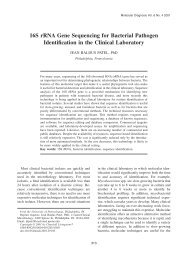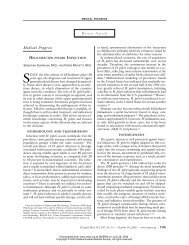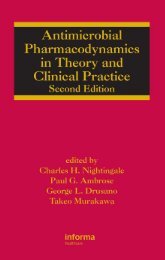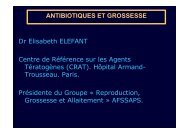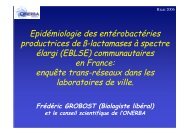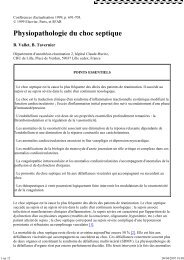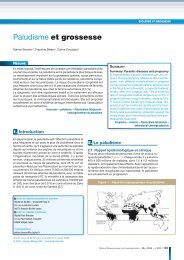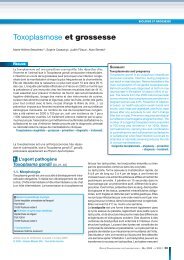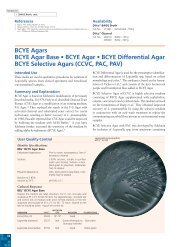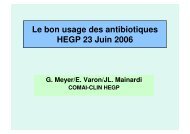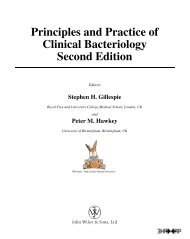coqueluche pour les nuls.pdf - Free
coqueluche pour les nuls.pdf - Free
coqueluche pour les nuls.pdf - Free
You also want an ePaper? Increase the reach of your titles
YUMPU automatically turns print PDFs into web optimized ePapers that Google loves.
Coqueluche 1<br />
Coqueluche<br />
Coqueluche<br />
CIM-10 :<br />
A37<br />
La <strong>coqueluche</strong> est une infection respiratoire bactérienne peu ou pas fébrile de l'arbre<br />
respiratoire inférieur, mais d'évolution longue et hautement contagieuse. Deux bactéries du<br />
genre des Bordetella sont responsab<strong>les</strong> des syndromes <strong>coqueluche</strong>ux chez l'être humain :<br />
Bordetella pertussis et Bordetella parapertussis.<br />
C’est une maladie longue (quatre à huit semaines) (après une période d'incubation d'une<br />
semaine) et éprouvante (caractérisée par de violentes quintes de toux dont le paroxysme<br />
évoque le chant du coq).<br />
Étymologie<br />
L’origine du nom de cette maladie <strong>pour</strong>rait provenir de coqueluchon, mot du XV e siècle<br />
désignant une sorte de capuche. [1]<br />
Une autre origine possible du nom est la toux évoquant le chant du coq.<br />
Historique<br />
La première description clinique authentique de la maladie est celle de Guillaume de<br />
Baillou en 1578, faite sous le nom de Tussis quintina. Ultérieurement, Thomas Sydenham<br />
en 1679, puis Thomas Willis en 1682 individualisent la maladie dont de nombreuses<br />
épidémies furent décrites en Europe durant <strong>les</strong> XVIII e et XIX e sièc<strong>les</strong>. En 1906, Ju<strong>les</strong> Bordet<br />
- d'où le nom de la bactérie - et Octave Gengou parviennent à l'isolement du bacille<br />
Bordetella pertussis par la mise au point d'un milieu de culture à base d'extrait de pommes<br />
de terre. La maladie fut reproduite <strong>pour</strong> la première fois en 1908 par Klimenko chez le<br />
singe et chez le chien. Les antibiotiques ont amélioré le pronostic de la <strong>coqueluche</strong> dont <strong>les</strong><br />
complications pulmonaires et cérébra<strong>les</strong> entraînaient une lourde mortalité infantile. Enfin,<br />
depuis <strong>les</strong> années 1940, la vaccination constitue un progrès remarquable dans la prévention<br />
de cette infection. Elle a en effet permis de diminuer l'intensité de cette maladie et surtout<br />
la mortalité <strong>coqueluche</strong>use, mais malheureusement uniquement dans <strong>les</strong> pays<br />
industrialisés.<br />
Actuellement, l'OMS estime qu'à travers le monde il y aurait environ 50 à 70 millions de cas<br />
de <strong>coqueluche</strong> survenant par an parmi <strong>les</strong>quels 300 000 enfants [2] [3] [4] décèdent chaque<br />
année, essentiellement dans <strong>les</strong> pays en voie de développement.<br />
En France, la <strong>coqueluche</strong> est devenue plus rare. Ceci est dû au fait que la couverture<br />
vaccinale date maintenant de 40 ans. Néanmoins depuis quelques années on observe une<br />
résurgence de la <strong>coqueluche</strong> en particulier chez <strong>les</strong> adultes et <strong>les</strong> ado<strong>les</strong>cents qui étaient<br />
anciennement vaccinés.
Coqueluche 2<br />
Recrudescence<br />
Les chiffres<br />
Depuis 1980, il y a une recrudescence de la <strong>coqueluche</strong> chez <strong>les</strong> ado<strong>les</strong>cents, <strong>les</strong> adultes et<br />
<strong>les</strong> nourrissons n’étant pas encore vaccinés. Elle se présente de forme sévère. En France<br />
entre 1999 et 2000, la <strong>coqueluche</strong> est la première cause de décès par infection bactérienne<br />
communautaire chez <strong>les</strong> nourrissons ayant entre 10 jours de vie et 2 mois. Mais c’est aussi<br />
la 3 e cause de décès tout âge confondu.<br />
Cette augmentation des sujets ayant la <strong>coqueluche</strong> a été observée aux États-Unis et au<br />
Canada. La France n’ayant pas de surveillance <strong>coqueluche</strong> au sein de la communauté, il<br />
faut se baser sur <strong>les</strong> chiffres des États-Unis et du Canada <strong>pour</strong> illustrer cette<br />
recrudescence.<br />
Aux États-Unis en 2005, 12000 cas de <strong>coqueluche</strong> ont été diagnostiqués, soit 6 fois plus<br />
qu'en 1980. De plus, au Canada, la proportion de cas de <strong>coqueluche</strong> chez <strong>les</strong> ado<strong>les</strong>cents<br />
(de ≥ 15 ans) et <strong>les</strong> adultes est passée de 9,6 % en 1995 à 31,3 % en 2004. Cette<br />
augmentation peut être sans doute attribuée au déclin de l'immunité chez <strong>les</strong> ado<strong>les</strong>cents<br />
et <strong>les</strong> adultes.<br />
L’explication<br />
Le profil habituel des personnes atteintes de la <strong>coqueluche</strong> a changé dû à la large<br />
couverture vaccinale. Elle est devenue presque absente de la tranche d’âge cible (6 mois à<br />
10 ans) mais elle est en pleine émergence chez <strong>les</strong> jeunes adultes. La <strong>coqueluche</strong> est<br />
devenue tardive et atypique. Dans cette nouvelle population cible, la <strong>coqueluche</strong> se<br />
manifeste avec des symptômes peu caractéristiques car elle est encore partiellement<br />
immunisée par <strong>les</strong> vaccins reçus pendant l’enfance. De ce fait, elle est difficile à<br />
diagnostiquer et elle fait plus penser à un gros rhume. Elle est rarement mortelle chez<br />
l’adulte. L’adulte représente un réservoir important de la maladie et une source majeure de<br />
transmission de l'infection aux nourrissons. Il est donc le plus souvent responsable de la<br />
contamination de nourrissons trop jeunes <strong>pour</strong> avoir eu une vaccination complète. Leur<br />
vaccination s’étale sur trois injections à 2, 3 et 4 mois mais elle ne confère une immunité<br />
correcte que vers 4 à 6 mois du au fait de l’immaturité du système immunitaire. Si l’âge de<br />
nourrisson est inférieur à 3 mois, il sera systématiquement hospitalisé.<br />
Pour diminuer cette recrudescence de la <strong>coqueluche</strong>, <strong>les</strong> deux solutions en vigueur sont :<br />
• Vacciner <strong>les</strong> adultes et <strong>les</strong> ado<strong>les</strong>cents. En France depuis 1998, un rappel du vaccin «<br />
acellulaire » est proposé aux enfants dès l’âge de 11 ans. En 2004, cette recommandation<br />
de rappel est aussi conseillée <strong>pour</strong> <strong>les</strong> adultes en contact avec des nourrissons tels que<br />
des professionnels ou des futurs parents. Mais la participation des ado<strong>les</strong>cents et des<br />
adultes à des programmes de vaccination est mauvaise.<br />
• Vacciner <strong>les</strong> nourrissons le plus tôt possible. Pour une protection optimale, il est<br />
nécessaire de faire 3 injections du vaccin à 1 mois d’intervalle. De ce fait, ils ne seraient<br />
pas totalement protégés jusqu’à l’âge de 4 mois.<br />
Cependant ces 2 solutions ne présentent pas une efficacité optimale d’où la recherche<br />
d’une troisième solution par <strong>les</strong> chercheurs de l’INSERM : le développement d’un nouveau<br />
vaccin.
Coqueluche 3<br />
Mode de transmission et mécanisme d'action<br />
La <strong>coqueluche</strong> est une maladie infectieuse très contagieuse surtout dans sa première phase<br />
alors qu'elle passe souvent inaperçue. La transmission s’opère par voie aérienne, la<br />
bactérie à l’origine de la maladie se propageant par des gouttelettes de salive lorsque le<br />
sujet malade tousse. La source de contamination est essentiellement constituée par <strong>les</strong><br />
enfants d’âge préscolaire ou scolaire, et aussi par <strong>les</strong> adultes et sujets âgés dont <strong>les</strong><br />
symptômes sont souvent mal identifiés. Le taux d’attaque est de 70-80 % si le contact est<br />
proche. Dans tous <strong>les</strong> cas, une enquête doit être menée autour du sujet malade <strong>pour</strong><br />
dépister <strong>les</strong> contaminateurs et <strong>les</strong> cas secondaires.<br />
Lorsque la bactérie Bordetella pertussis pénètre dans <strong>les</strong> voies respiratoires, elle<br />
commence à se multiplier sur l’épithélium cilié respiratoire de la trachée et des bronches.<br />
La bactérie diffuse plusieurs toxines spécifiques qui provoquent la maladie : la <strong>coqueluche</strong><br />
est une maladie toxinique.<br />
Ceci permet une action préventive en traitant rapidement <strong>les</strong> autres malades <strong>pour</strong> éviter la<br />
propagation de la maladie, notamment chez <strong>les</strong> sujets à risque : nouveau-nés, petits<br />
nourrissons et femmes enceintes, asthmatiques etc.<br />
Le risque de contamination est augmenté selon différents facteurs :<br />
• une exposition aux sécrétions émises lors de la toux prolongée et répétée<br />
• une enceinte de petite dimension et fermée<br />
• le contaminateur se trouve dans une phase plus précoce de sa maladie<br />
La contagiosité diminue avec le temps : maximale pendant la phase catarrhale (où le<br />
patient tousse), elle devient nulle après 5 jours de traitement antibiotique efficace. En<br />
l'absence de traitement, la phase contagieuse peut atteindre trois semaines.<br />
Terrain<br />
La <strong>coqueluche</strong> touche toutes <strong>les</strong> tranches d’âge, mais ses manifestations cliniques varient<br />
en fonction de l’âge.<br />
Elle peut survenir chez des individus préalablement vaccinés ou qui ont déjà été infectés,<br />
mais en ce cas, le tableau clinique est atténué.<br />
Dans <strong>les</strong> populations très majoritairement vaccinées, la population la plus vulnérable et la<br />
quasi-totalité des décès concernent <strong>les</strong> nourrissons de moins d'un an tandis que, chez <strong>les</strong><br />
populations non vaccinées, la maladie touche également <strong>les</strong> enfants et <strong>les</strong> nourrissons plus<br />
âgés. La <strong>coqueluche</strong> est une maladie qui peut mettre en jeu le pronostic vital du patient : la<br />
mort peut survenir en quelques jours si le traitement adapté n'est pas prescrit.<br />
Manifestations cliniques<br />
Symptômes<br />
Les symptômes de la <strong>coqueluche</strong> sont variab<strong>les</strong> selon <strong>les</strong> individus. Chez le nourrisson en<br />
revanche, la <strong>coqueluche</strong> est généralement sévère et atypique.<br />
La période d'incubation est la période silencieuse correspondant au développement dans<br />
l'organisme des germes à l'origine de la <strong>coqueluche</strong> sans qu’il y ait manifestation de<br />
symptômes. Elle dure de 5 à 21 jours, en étant proche de 7 jours dans la plupart des cas.<br />
Cette période correspond au délai entre la contamination et l'apparition des premiers
Coqueluche 4<br />
signes.<br />
La maladie débute ensuite par une période catarrhale pendant laquelle on observe des<br />
signes non spécifiques d’infection des voies aériennes supérieures : rhinite, éternuement,<br />
toux, fièvre. Elle peut ainsi être confondue avec un simple rhume. Elle dure de 1 à 2<br />
semaines.<br />
Elle est suivie par la période des quintes de toux, caractéristique de la <strong>coqueluche</strong>. Chaque<br />
quinte est composée de cinq secousses expiratoires suivies d'une longue inspiration<br />
bruyante appelée chant du coq. Durant cette phase l'enfant est épuisé par la succession des<br />
quintes. Les quintes de toux peuvent également provoquer des crises de suffocation, des<br />
vomissements, une apnée, et chez <strong>les</strong> jeunes enfants une cyanose (coloration bleue ou<br />
violette de la peau et des muqueuses). Le nombre de quintes par jour est variable, avec un<br />
maximum la nuit. Entre <strong>les</strong> quintes, l'examen clinique est normal, il n'y a pas de fièvre.<br />
Cette période dure de 2 à 4 semaines.<br />
La phase de déclin et de conva<strong>les</strong>cence commence ensuite vers la 9 e ou la 10 e semaine.<br />
Incidence de facteurs extérieurs sur la maladie<br />
Une étude réalisée en Nouvelle-Écosse montre que <strong>les</strong> enfants vaccinés qui étaient<br />
culture-positifs <strong>pour</strong> Bordetella pertussis présentaient, <strong>pour</strong> la plupart, une toux<br />
<strong>coqueluche</strong>use typique : 88 % répondaient à la définition du cas de l’OMS, mais aucun n’a<br />
été hospitalisé. Un traitement précoce à l’érythromycine réduisait la durée de la toux et des<br />
quintes. La moitié des contacts familiaux des malades ont développé une toux pathologique<br />
et 37,5 % d’entre eux répondaient à la définition de l’OMS, résultats qui montrent combien<br />
cette maladie est contagieuse.<br />
La plupart des hospitalisations concernent <strong>les</strong> enfants de moins de cinq ans. La plus longue<br />
durée d’hospitalisation s’observe chez <strong>les</strong> enfants de moins de six mois, qui sont par ailleurs<br />
plus susceptib<strong>les</strong> d’être hospitalisés en services de soins intensifs.<br />
Le tableau chez le nourrisson de moins de 6 mois est moins typique :<br />
• L'écoulement rhinopharyngé et la toux sont moins marqués ;<br />
• Les quintes sont peu nombreuses ;<br />
• Les apnées et <strong>les</strong> accès de cyanose sont au premier plan, nécessitant une surveillance de<br />
tous <strong>les</strong> instants.<br />
De même, chez l'adulte, la toux peut être tout à fait banale, mais prolongée.<br />
L'infection est immunogène et la personne est donc par la suite protégée de toute nouvelle<br />
<strong>coqueluche</strong> pendant plusieurs années.<br />
Les complications de la <strong>coqueluche</strong> sont rares depuis le recours à la vaccination.<br />
Néanmoins la <strong>coqueluche</strong> peut entraîner une otite moyenne, une pneumonie, une<br />
atélectasie, des convulsions, une encéphalopathie, un amaigrissement, des hernies, un<br />
décès, etc.…
Coqueluche 5<br />
Examens et analyses complémentaires<br />
Principaux examens réalisés<br />
• Numération formule sanguine<br />
• Radiographie pulmonaire<br />
• Bactériologie<br />
Diagnostic<br />
Le diagnostic clinique est souvent suffisant mais dans <strong>les</strong> formes atypiques la confirmation<br />
bactériologique peut être indiquée.<br />
L’identification du germe dans <strong>les</strong> sécrétions respiratoires (crachats ou prélèvements du<br />
pharynx) est le seul argument qui nous permet de diagnostiquer avec certitude la maladie.<br />
On l’obtient grâce à la bactériologie. Cet examen est particulièrement utile lors de la phase<br />
catarrhale et dans <strong>les</strong> formes atténuées de la <strong>coqueluche</strong>. Malheureusement, le rendement<br />
de cet examen est plutôt faible (sensibilité entre 15 et 45%).<br />
Cette sensibilité est peut être améliorée si on recherche <strong>les</strong> gènes de la bactérie par PCR.<br />
Cette technique permet en effet un diagnostic rapide mais elle est encore réservée à des<br />
centres spécialisés.<br />
À une phase plus tardive (ou lorsque la mise sous antibiotique a pu faire disparaître tout<br />
germe), le diagnostic peut être fait par le dosage d'immunoglobuline G dans le sang du<br />
patient. En cas de <strong>coqueluche</strong> ce taux est anormalement élevé. Cette élévation peut durer<br />
plusieurs mois et atteint parfois un an. Ce taux est également élevé en cas de vaccination<br />
contre la <strong>coqueluche</strong>.<br />
Diagnostic différentiel<br />
D’autres causes d’une toux rebelle peuvent être :<br />
• Corps étranger trachéo-bronchique chez le jeune enfant<br />
• Tuberculose<br />
• Mucoviscidose<br />
• Laryngotrachéite infectieuse<br />
• Pneumonie<br />
• Allergies respiratoires<br />
Traitements<br />
Traitement curatif<br />
Le traitement fait appel essentiellement à des antibiotiques (macrolides) dans <strong>les</strong> 3<br />
premières semaines d'évolution. Ils permettent d'éliminer la présence de la bactérie dans<br />
<strong>les</strong> secrétions et de réduire ainsi rapidement la contagiosité. Le retour en collectivité est<br />
alors possible après 5 jours de traitement. Administré tôt, au début de la phase catarrhale,<br />
le traitement permet parfois d'écourter la maladie, voire d'éviter la phase des quintes et de<br />
limiter la transmission à l'entourage, diminuant ainsi le réservoir. Cela impose de débuter<br />
l'antibiotique dès la suspicion de la maladie, sans attendre la confirmation des analyses de<br />
laboratoire.
Coqueluche 6<br />
Il est également recommandé de donner un traitement antibiotique préventif chez <strong>les</strong><br />
personnes à risque par de l'érythromycine. Il en est de même <strong>pour</strong> toutes <strong>les</strong> personnes de<br />
l'entourage proche du malade quel que soit leur âge ou leur état d'immunisation.<br />
L’hospitalisation est justifiée <strong>pour</strong> <strong>les</strong> enfants de moins de 6 mois lorsque la <strong>coqueluche</strong><br />
s’avère grave. Elle permet de mettre en place une surveillance cardio-respiratoire et un<br />
nursing adapté pendant la phase aiguë.<br />
Les autres thérapeutiques (fluidifiants, salbutamol, corticoïdes...) restent discutées au cours<br />
de la <strong>coqueluche</strong> ou sont inuti<strong>les</strong>. Les gammaglobulines standards ne doivent pas être<br />
prescrites.<br />
D’autres mesures peuvent être prises <strong>pour</strong> aider à surmonter la maladie :<br />
• Veiller au bon état d’hydratation et de nutrition ;<br />
• Assurer un apport alimentaire suffisant, fractionné avec si besoin des suppléments<br />
énergétiques.<br />
• Favoriser l’évacuation bronchique et une bonne ventilation pulmonaire à l’aide de la<br />
kinésithérapie respiratoire si elle est bien supportée,<br />
• Isolement et surveillance du sujet malade,<br />
• Chez l’enfant, le faire asseoir lors des quintes de toux, le faire cracher <strong>pour</strong> dégager <strong>les</strong><br />
voies respiratoires, le tranquilliser (l'angoisse peut majorer <strong>les</strong> crises).<br />
Exemple d’un traitement type :<br />
• L'érythromycine 50 mg/Kg/J en 2 prises ou 2 g/jour, mais des études font penser que <strong>les</strong><br />
nouveaux macrolides sont également actifs.<br />
Le traitement doit durer 15 jours.<br />
• L'azithromycine<br />
• Le Co-trimoxazole peut également être utilisé aux doses adultes de 800 mg matin et soir,<br />
15 jours.<br />
Anecdotes<br />
Il avait été évoqué <strong>les</strong> bienfaits d'un passage en altitude <strong>pour</strong> soigner cette maladie. De<br />
nombreux enfants ont ainsi eu droit à un baptême de l'air à l'occasion d'une <strong>coqueluche</strong>.<br />
Cela se pratiquait encore récemment.<br />
Vaccination<br />
La <strong>coqueluche</strong> peut être mortelle chez <strong>les</strong> nourrissons en particulier ceux de moins de 4<br />
mois. C'est <strong>pour</strong> cela que l'on recommande aux jeunes parents d'être vaccinés, <strong>pour</strong> ne pas<br />
contaminer leurs enfants qui seront vaccinés à partir de 2 mois. Le rapport bénéfice/risque<br />
a été évalué, il est en faveur de la vaccination.<br />
La vaccination anti-<strong>coqueluche</strong> a été développée dans <strong>les</strong> années 1940. En France le<br />
premier vaccin <strong>coqueluche</strong>ux a été introduit en 1959 et la vaccination s'est généralisée à<br />
partir de 1966 grâce à l'association aux autres vaccins de la diphtérie, du tétanos et de la<br />
poliomyélite. Le maintien d'une bonne couverture vaccinale a permis de réduire de façon<br />
spectaculaire la morbidité et la mortalité <strong>coqueluche</strong>use.<br />
Il existe deux principaux types de vaccins :<br />
• Les vaccins anti-<strong>coqueluche</strong>ux à germes entiers : ils sont constitués du germe entier de<br />
Bordetella pertussis, bactérie responsable de la <strong>coqueluche</strong>, qui a été inactivée à la
Coqueluche 7<br />
chaleur ou chimiquement. Ces vaccins ont une efficacité de 95% après 3 injections et leur<br />
durée de protection est de 8 ans <strong>pour</strong> le vaccin français. Cependant ces vaccins peuvent<br />
comporter certaines réactions indésirab<strong>les</strong>.<br />
• Les vaccins anti-<strong>coqueluche</strong>ux acellulaires : ils ont été développés au Japon dans <strong>les</strong><br />
années 1970/80. Ils comportent de 2 à 5 antigènes de Bordetella pertussis. Ils sont<br />
beaucoup plus coûteux que <strong>les</strong> vaccins à germes entiers et ne sont pas facilement<br />
abordab<strong>les</strong> <strong>pour</strong> <strong>les</strong> pays en voie de développement. Ils ont une efficacité inférieure de 5<br />
à 10% aux vaccins à germes entiers. Le recul est également insuffisant <strong>pour</strong> évaluer la<br />
durée de sa protection. Néanmoins, il présente une meilleure tolérance (moins d’effets<br />
indésirab<strong>les</strong>).<br />
Ces deux types de vaccins sont tous deux largement utilisés dans <strong>les</strong> pays occidentaux. Le<br />
deuxième vaccin présente moins d’effets secondaires que le premier mais il confère une<br />
moins bonne immunité. Certains pays utilisent donc le vaccin à germes entiers <strong>pour</strong> la<br />
primo-vaccination et le vaccin acellulaire <strong>pour</strong> <strong>les</strong> doses de rappel dans <strong>les</strong> tranches d’âge<br />
supérieures. D’autres, comme l’Allemagne et la Suède, utilisent le vaccin acellulaire aussi<br />
bien <strong>pour</strong> la primo-vaccination que <strong>pour</strong> <strong>les</strong> rappels.<br />
Ces vaccins sont administrés en trois injections à 2, 3 et 4 mois. Cependant, étant donné<br />
l’immaturité du système immunitaire des nourrissons, ils ne confèrent une immunité<br />
correcte que vers 4 à 6 mois. Cette population de nourrissons trop jeunes <strong>pour</strong> être<br />
complètement vaccinés pose de graves problèmes. Ils sont contaminés 3 à 5 fois sur 10 par<br />
leur entourage familial, d’où des recherches <strong>pour</strong> un nouveau vaccin. Des rappels sont<br />
ensuite recommandés à 18 mois et d’autres à quatre ans.<br />
En France, un vaccin tétravalent contenant une dose de vaccin anti-<strong>coqueluche</strong>ux<br />
acellulaire est destiné aux ado<strong>les</strong>cents et adultes <strong>pour</strong> <strong>les</strong> rappels. En effet, suite à la<br />
recrudescence de la Coqueluche, un rappel tardif à 11-13 ans est conseillé depuis 1998. De<br />
même, depuis 2004, ce rappel est également recommandé aux jeunes parents, aux<br />
personnes à risque et au personnel de santé en contact avec des nouveau-nés.<br />
Effets indésirab<strong>les</strong><br />
• Fièvres,<br />
• Survenue d'érythème (rougeur cutanée),<br />
• Apparition de légers durillons sur la peau,<br />
• Syndrome des cris persistants,<br />
• Cyanose,<br />
• Réactions du système nerveux par des convulsions, de spasmes des musc<strong>les</strong> ou<br />
d'encéphalomyélite (très rare),<br />
• Survenu de réactions inflammatoires,<br />
• État de choc et autres réactions rares tel<strong>les</strong> que des encéphalopathies.
Coqueluche 8<br />
Contre indications<br />
• Des antécédents d'allergie,<br />
• Des réactions intenses à d'autres vaccins,<br />
• Les enfants âgés de plus de 6 ans,<br />
• Les encéphalopathies évolutives,<br />
• Fièvre (égale ou supérieur à 40°C),<br />
• Une affection chronique,<br />
• Des affections graves de l'appareil pulmonaire,<br />
• Lorsque l'on constate la survenue de manifestations neurologiques, il est déconseillé de<br />
procéder aux injections suivantes.<br />
• Chez la femme enceinte, le vaccin anti-<strong>coqueluche</strong>ux est susceptible des fièvres. Il existe<br />
d'autre part des risques d'avortement et d'accouchement prématuré.<br />
Voir aussi<br />
• Bordetella pertussis.<br />
• Liste des bactéries pathogènes <strong>pour</strong> l'Homme.<br />
• Pédiatrie.<br />
Liens externes<br />
• [http:/ / hdl. handle. net/ 1871/ 10211 Pertussis: new insights in diagnosis, incidence and<br />
clinical manifestations, F.G.A. Versteegh, Thesis, 2005]<br />
• Recrudescence de cas de <strong>coqueluche</strong> en France [5] — communiqué de presse de<br />
l'InVS, 21 janvier 2005<br />
• Guide des conduites à tenir en cas de maladie transmissible dans une collectivité<br />
d'enfants [6]<br />
• Rapport du conseil supérieur d'hygiène publique de France section maladies<br />
transmissib<strong>les</strong> [7]<br />
• Whooping cough home page [8]<br />
• Vulgaris médical La <strong>coqueluche</strong> [9]<br />
Références<br />
[1] TLFi, Accès au direct à l'article dans le TLFi (http:/ / www. cnrtl. fr/ definition/<br />
<strong>coqueluche</strong>/ )<br />
[2] http:/ / www. who. int/ vaccines-documents/ DocsPDF01/ www657. <strong>pdf</strong>|OMS - 2001<br />
[3] http:/ / www. who. int/ whr/ 2003/ en/ Facts_and_Figures-fr. <strong>pdf</strong>|OMS - 2003<br />
[4] http:/ / www. who. int/ whr/ 2004/ annex/ topic/ en/ annex_2_fr. <strong>pdf</strong>|OMS - 2004<br />
[5] http:/ / www. invs. sante. fr/ presse/ 2005/ communiques/ <strong>coqueluche</strong>_210105/ index.<br />
html<br />
[6] http:/ / www. sante. gouv. fr/ htm/ dossiers/ maladie_enfant/ 5maladie. htm<br />
[7] http:/ / www. sante. gouv. fr/ htm/ dossiers/ cshpf/ r_mt_0104_<strong>coqueluche</strong>. <strong>pdf</strong><br />
[8] http:/ / www. whoopingcough. net/<br />
[9] http:/ / www. vulgaris-medical. com/ encyclopedie/ <strong>coqueluche</strong>-7427. html<br />
• (en) [http:/ / www. thelancet. com/ journals/ lancet/ article/ PIIS014067360668848X/<br />
abstract Recent developments in pertussis, N Crowcroft, R Pebody, Lancet 2006; 367:<br />
1926–36]
Coqueluche 9<br />
• Versteegh FGA, Schellekens JFP, Fleer A, Roord JJ. (2005). "Pertussis: a concise<br />
historical review including diagnosis, incidence, clinical manifestations and the role of<br />
treatment and vaccination in management." Rev Med Microbiol 16 (3): 79–89.<br />
Source: http:/ / fr. wikipedia. org/ w/ index. php oldid=38621964<br />
Contributors: 63nurb, Asabengurtza, Benoit rigaut, Camobap, Chphe, Chtfn, DocteurCosmos, Grook Da Oger,<br />
Gédé, HellDragon, JY Rehby, Jgal170255, Larzac, Looler, Mathieuw, Mikis, Nguyenld, Nojhan, Nono64,<br />
PolytechTIS(CJ-VR-ML-SF), Romanc19s, Scorpius59, Sebleouf, Slm85, Toxicotravail, 26 anonymous edits
Licence 10<br />
Licence<br />
Version 1.2, November 2002<br />
Copyright (C) 2000,2001,2002 <strong>Free</strong> Software Foundation, Inc. 51 Franklin St, Fifth Floor, Boston, MA 02110-1301 USA Everyone is permitted to copy<br />
and distribute verbatim copies of this license document, but changing it is not allowed.<br />
0. PREAMBLE<br />
The purpose of this License is to make a manual, textbook, or other functional and useful document "free" in the sense of freedom: to assure everyone<br />
the effective freedom to copy and redistribute it, with or without modifying it, either commercially or noncommercially. Secondarily, this License<br />
preserves for the author and publisher a way to get credit for their work, while not being considered responsible for modifications made by others.<br />
This License is a kind of "copyleft", which means that derivative works of the document must themselves be free in the same sense. It complements the<br />
GNU General Public License, which is a copyleft license designed for free software.<br />
We have designed this License in order to use it for manuals for free software, because free software needs free documentation: a free program should<br />
come with manuals providing the same freedoms that the software does. But this License is not limited to software manuals; it can be used for any<br />
textual work, regard<strong>les</strong>s of subject matter or whether it is published as a printed book. We recommend this License principally for works whose purpose<br />
is instruction or reference.<br />
1. APPLICABILITY AND DEFINITIONS<br />
This License applies to any manual or other work, in any medium, that contains a notice placed by the copyright holder saying it can be distributed under<br />
the terms of this License. Such a notice grants a world-wide, royalty-free license, unlimited in duration, to use that work under the conditions stated<br />
herein. The "Document", below, refers to any such manual or work. Any member of the public is a licensee, and is addressed as "you". You accept the<br />
license if you copy, modify or distribute the work in a way requiring permission under copyright law.<br />
A "Modified Version" of the Document means any work containing the Document or a portion of it, either copied verbatim, or with modifications and/or<br />
translated into another language.<br />
A "Secondary Section" is a named appendix or a front-matter section of the Document that deals exclusively with the relationship of the publishers or<br />
authors of the Document to the Document's overall subject (or to related matters) and contains nothing that could fall directly within that overall subject.<br />
(Thus, if the Document is in part a textbook of mathematics, a Secondary Section may not explain any mathematics.) The relationship could be a matter<br />
of historical connection with the subject or with related matters, or of legal, commercial, philosophical, ethical or political position regarding them.<br />
The "Invariant Sections" are certain Secondary Sections whose tit<strong>les</strong> are designated, as being those of Invariant Sections, in the notice that says that the<br />
Document is released under this License. If a section does not fit the above definition of Secondary then it is not allowed to be designated as Invariant.<br />
The Document may contain zero Invariant Sections. If the Document does not identify any Invariant Sections then there are none.<br />
The "Cover Texts" are certain short passages of text that are listed, as Front-Cover Texts or Back-Cover Texts, in the notice that says that the Document<br />
is released under this License. A Front-Cover Text may be at most 5 words, and a Back-Cover Text may be at most 25 words.<br />
A "Transparent" copy of the Document means a machine-readable copy, represented in a format whose specification is available to the general public,<br />
that is suitable for revising the document straightforwardly with generic text editors or (for images composed of pixels) generic paint programs or (for<br />
drawings) some widely available drawing editor, and that is suitable for input to text formatters or for automatic translation to a variety of formats<br />
suitable for input to text formatters. A copy made in an otherwise Transparent file format whose markup, or absence of markup, has been arranged to<br />
thwart or discourage subsequent modification by readers is not Transparent. An image format is not Transparent if used for any substantial amount of<br />
text. A copy that is not "Transparent" is called "Opaque".<br />
Examp<strong>les</strong> of suitable formats for Transparent copies include plain ASCII without markup, Texinfo input format, LaTeX input format, SGML or XML using<br />
a publicly available DTD, and standard-conforming simple HTML, PostScript or PDF designed for human modification. Examp<strong>les</strong> of transparent image<br />
formats include PNG, XCF and JPG. Opaque formats include proprietary formats that can be read and edited only by proprietary word processors, SGML<br />
or XML for which the DTD and/or processing tools are not generally available, and the machine-generated HTML, PostScript or PDF produced by some<br />
word processors for output purposes only.<br />
The "Title Page" means, for a printed book, the title page itself, plus such following pages as are needed to hold, legibly, the material this License<br />
requires to appear in the title page. For works in formats which do not have any title page as such, "Title Page" means the text near the most prominent<br />
appearance of the work's title, preceding the beginning of the body of the text.<br />
A section "Entitled XYZ" means a named subunit of the Document whose title either is precisely XYZ or contains XYZ in parentheses following text that<br />
translates XYZ in another language. (Here XYZ stands for a specific section name mentioned below, such as "Acknowledgements", "Dedications",<br />
"Endorsements", or "History".) To "Preserve the Title" of such a section when you modify the Document means that it remains a section "Entitled XYZ"<br />
according to this definition.<br />
The Document may include Warranty Disclaimers next to the notice which states that this License applies to the Document. These Warranty Disclaimers<br />
are considered to be included by reference in this License, but only as regards disclaiming warranties: any other implication that these Warranty<br />
Disclaimers may have is void and has no effect on the meaning of this License.<br />
2. VERBATIM COPYING<br />
You may copy and distribute the Document in any medium, either commercially or noncommercially, provided that this License, the copyright notices,<br />
and the license notice saying this License applies to the Document are reproduced in all copies, and that you add no other conditions whatsoever to<br />
those of this License. You may not use technical measures to obstruct or control the reading or further copying of the copies you make or distribute.<br />
However, you may accept compensation in exchange for copies. If you distribute a large enough number of copies you must also follow the conditions in<br />
section 3.<br />
You may also lend copies, under the same conditions stated above, and you may publicly display copies.<br />
3. COPYING IN QUANTITY<br />
If you publish printed copies (or copies in media that commonly have printed covers) of the Document, numbering more than 100, and the Document's<br />
license notice requires Cover Texts, you must enclose the copies in covers that carry, clearly and legibly, all these Cover Texts: Front-Cover Texts on the<br />
front cover, and Back-Cover Texts on the back cover. Both covers must also clearly and legibly identify you as the publisher of these copies. The front<br />
cover must present the full title with all words of the title equally prominent and visible. You may add other material on the covers in addition. Copying<br />
with changes limited to the covers, as long as they preserve the title of the Document and satisfy these conditions, can be treated as verbatim copying in<br />
other respects.<br />
If the required texts for either cover are too voluminous to fit legibly, you should put the first ones listed (as many as fit reasonably) on the actual cover,<br />
and continue the rest onto adjacent pages.<br />
If you publish or distribute Opaque copies of the Document numbering more than 100, you must either include a machine-readable Transparent copy<br />
along with each Opaque copy, or state in or with each Opaque copy a computer-network location from which the general network-using public has<br />
access to download using public-standard network protocols a complete Transparent copy of the Document, free of added material. If you use the latter<br />
option, you must take reasonably prudent steps, when you begin distribution of Opaque copies in quantity, to ensure that this Transparent copy will<br />
remain thus accessible at the stated location until at least one year after the last time you distribute an Opaque copy (directly or through your agents or<br />
retailers) of that edition to the public.<br />
It is requested, but not required, that you contact the authors of the Document well before redistributing any large number of copies, to give them a<br />
chance to provide you with an updated version of the Document.<br />
4. MODIFICATIONS<br />
You may copy and distribute a Modified Version of the Document under the conditions of sections 2 and 3 above, provided that you release the Modified<br />
Version under precisely this License, with the Modified Version filling the role of the Document, thus licensing distribution and modification of the<br />
Modified Version to whoever possesses a copy of it. In addition, you must do these things in the Modified Version:<br />
A. Use in the Title Page (and on the covers, if any) a title distinct from that of the Document, and from those of previous versions (which should, if there<br />
were any, be listed in the History section of the Document). You may use the same title as a previous version if the original publisher of that version<br />
gives permission.<br />
B. List on the Title Page, as authors, one or more persons or entities responsible for authorship of the modifications in the Modified Version, together<br />
with at least five of the principal authors of the Document (all of its principal authors, if it has fewer than five), un<strong>les</strong>s they release you from this<br />
requirement.<br />
C. State on the Title page the name of the publisher of the Modified Version, as the publisher.<br />
D. Preserve all the copyright notices of the Document.<br />
E. Add an appropriate copyright notice for your modifications adjacent to the other copyright notices.<br />
F. Include, immediately after the copyright notices, a license notice giving the public permission to use the Modified Version under the terms of this<br />
License, in the form shown in the Addendum below.<br />
G. Preserve in that license notice the full lists of Invariant Sections and required Cover Texts given in the Document's license notice.<br />
H. Include an unaltered copy of this License.<br />
I. Preserve the section Entitled "History", Preserve its Title, and add to it an item stating at least the title, year, new authors, and publisher of the<br />
Modified Version as given on the Title Page. If there is no section Entitled "History" in the Document, create one stating the title, year, authors, and<br />
publisher of the Document as given on its Title Page, then add an item describing the Modified Version as stated in the previous sentence.
Licence 11<br />
J. Preserve the network location, if any, given in the Document for public access to a Transparent copy of the Document, and likewise the network<br />
locations given in the Document for previous versions it was based on. These may be placed in the "History" section. You may omit a network<br />
location for a work that was published at least four years before the Document itself, or if the original publisher of the version it refers to gives<br />
permission.<br />
K. For any section Entitled "Acknowledgements" or "Dedications", Preserve the Title of the section, and preserve in the section all the substance and<br />
tone of each of the contributor acknowledgements and/or dedications given therein.<br />
L. Preserve all the Invariant Sections of the Document, unaltered in their text and in their tit<strong>les</strong>. Section numbers or the equivalent are not considered<br />
part of the section tit<strong>les</strong>.<br />
M. Delete any section Entitled "Endorsements". Such a section may not be included in the Modified Version.<br />
N. Do not retitle any existing section to be Entitled "Endorsements" or to conflict in title with any Invariant Section.<br />
O. Preserve any Warranty Disclaimers.<br />
If the Modified Version includes new front-matter sections or appendices that qualify as Secondary Sections and contain no material copied from the<br />
Document, you may at your option designate some or all of these sections as invariant. To do this, add their tit<strong>les</strong> to the list of Invariant Sections in the<br />
Modified Version's license notice. These tit<strong>les</strong> must be distinct from any other section tit<strong>les</strong>.<br />
You may add a section Entitled "Endorsements", provided it contains nothing but endorsements of your Modified Version by various parties--for example,<br />
statements of peer review or that the text has been approved by an organization as the authoritative definition of a standard.<br />
You may add a passage of up to five words as a Front-Cover Text, and a passage of up to 25 words as a Back-Cover Text, to the end of the list of Cover<br />
Texts in the Modified Version. Only one passage of Front-Cover Text and one of Back-Cover Text may be added by (or through arrangements made by)<br />
any one entity. If the Document already includes a cover text for the same cover, previously added by you or by arrangement made by the same entity<br />
you are acting on behalf of, you may not add another; but you may replace the old one, on explicit permission from the previous publisher that added the<br />
old one.<br />
The author(s) and publisher(s) of the Document do not by this License give permission to use their names for publicity for or to assert or imply<br />
endorsement of any Modified Version.<br />
5. COMBINING DOCUMENTS<br />
You may combine the Document with other documents released under this License, under the terms defined in section 4 above for modified versions,<br />
provided that you include in the combination all of the Invariant Sections of all of the original documents, unmodified, and list them all as Invariant<br />
Sections of your combined work in its license notice, and that you preserve all their Warranty Disclaimers.<br />
The combined work need only contain one copy of this License, and multiple identical Invariant Sections may be replaced with a single copy. If there are<br />
multiple Invariant Sections with the same name but different contents, make the title of each such section unique by adding at the end of it, in<br />
parentheses, the name of the original author or publisher of that section if known, or else a unique number. Make the same adjustment to the section<br />
tit<strong>les</strong> in the list of Invariant Sections in the license notice of the combined work.<br />
In the combination, you must combine any sections Entitled "History" in the various original documents, forming one section Entitled "History"; likewise<br />
combine any sections Entitled "Acknowledgements", and any sections Entitled "Dedications". You must delete all sections Entitled "Endorsements."<br />
6. COLLECTIONS OF DOCUMENTS<br />
You may make a collection consisting of the Document and other documents released under this License, and replace the individual copies of this<br />
License in the various documents with a single copy that is included in the collection, provided that you follow the ru<strong>les</strong> of this License for verbatim<br />
copying of each of the documents in all other respects.<br />
You may extract a single document from such a collection, and distribute it individually under this License, provided you insert a copy of this License into<br />
the extracted document, and follow this License in all other respects regarding verbatim copying of that document.<br />
7. AGGREGATION WITH INDEPENDENT WORKS<br />
A compilation of the Document or its derivatives with other separate and independent documents or works, in or on a volume of a storage or distribution<br />
medium, is called an "aggregate" if the copyright resulting from the compilation is not used to limit the legal rights of the compilation's users beyond<br />
what the individual works permit. When the Document is included in an aggregate, this License does not apply to the other works in the aggregate which<br />
are not themselves derivative works of the Document.<br />
If the Cover Text requirement of section 3 is applicable to these copies of the Document, then if the Document is <strong>les</strong>s than one half of the entire<br />
aggregate, the Document's Cover Texts may be placed on covers that bracket the Document within the aggregate, or the electronic equivalent of covers<br />
if the Document is in electronic form. Otherwise they must appear on printed covers that bracket the whole aggregate.<br />
8. TRANSLATION<br />
Translation is considered a kind of modification, so you may distribute translations of the Document under the terms of section 4. Replacing Invariant<br />
Sections with translations requires special permission from their copyright holders, but you may include translations of some or all Invariant Sections in<br />
addition to the original versions of these Invariant Sections. You may include a translation of this License, and all the license notices in the Document,<br />
and any Warranty Disclaimers, provided that you also include the original English version of this License and the original versions of those notices and<br />
disclaimers. In case of a disagreement between the translation and the original version of this License or a notice or disclaimer, the original version will<br />
prevail.<br />
If a section in the Document is Entitled "Acknowledgements", "Dedications", or "History", the requirement (section 4) to Preserve its Title (section 1) will<br />
typically require changing the actual title.<br />
9. TERMINATION<br />
You may not copy, modify, sublicense, or distribute the Document except as expressly provided for under this License. Any other attempt to copy, modify,<br />
sublicense or distribute the Document is void, and will automatically terminate your rights under this License. However, parties who have received<br />
copies, or rights, from you under this License will not have their licenses terminated so long as such parties remain in full compliance.<br />
10. FUTURE REVISIONS OF THIS LICENSE<br />
The <strong>Free</strong> Software Foundation may publish new, revised versions of the GNU <strong>Free</strong> Documentation License from time to time. Such new versions will be<br />
similar in spirit to the present version, but may differ in detail to address new problems or concerns. See http:/ / www. gnu. org/ copyleft/ .<br />
Each version of the License is given a distinguishing version number. If the Document specifies that a particular numbered version of this License "or<br />
any later version" applies to it, you have the option of following the terms and conditions either of that specified version or of any later version that has<br />
been published (not as a draft) by the <strong>Free</strong> Software Foundation. If the Document does not specify a version number of this License, you may choose any<br />
version ever published (not as a draft) by the <strong>Free</strong> Software Foundation.<br />
How to use this License for your documents<br />
To use this License in a document you have written, include a copy of the License in the document and put the following copyright and license notices<br />
just after the title page:<br />
Copyright (c) YEAR YOUR NAME. Permission is granted to copy, distribute and/or modify this document under the terms of the GNU <strong>Free</strong><br />
Documentation License, Version 1.2 or any later version published by the <strong>Free</strong> Software Foundation; with no Invariant Sections, no Front-Cover Texts,<br />
and no Back-Cover Texts. A copy of the license is included in the section entitled "GNU <strong>Free</strong> Documentation License".<br />
If you have Invariant Sections, Front-Cover Texts and Back-Cover Texts, replace the "with...Texts." line with this:<br />
with the Invariant Sections being LIST THEIR TITLES, with the Front-Cover Texts being LIST, and with the Back-Cover Texts being LIST.<br />
If you have Invariant Sections without Cover Texts, or some other combination of the three, merge those two alternatives to suit the situation.<br />
If your document contains nontrivial examp<strong>les</strong> of program code, we recommend releasing these examp<strong>les</strong> in parallel under your choice of free software<br />
license, such as the GNU General Public License, to permit their use in free software.




